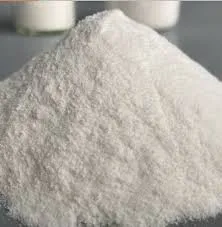
Nov . 26, 2024 04:51 Back to list
Safety Data Sheet for Hydroxypropyl Methyl Cellulose and Its Properties
Understanding Hydroxypropyl Methylcellulose Properties, Safety, and Applications
Hydroxypropyl Methylcellulose (HPMC) is a non-ionic cellulose ether derived from natural cellulose. It is widely utilized in various industries due to its unique properties, including thickening, emulsifying, and film-forming capabilities. This article aims to elucidate the characteristics, safety information, and diverse applications of HPMC, particularly in the context of its Material Safety Data Sheet (MSDS).
Chemical Composition and Properties
HPMC is synthesized through the modification of cellulose, involving the substitution of hydroxyl groups with hydroxypropyl and methyl groups. This chemical alteration results in a versatile compound that exhibits exceptional solubility in water, particularly in hot water, and forms a clear, viscous solution upon dispersion. The viscosity of HPMC can be adjusted by varying the degree of substitution and the molecular weight, allowing for tailored formulations to meet specific application needs.
In terms of its physical properties, HPMC is a white to off-white powder that is odorless and tasteless. It has excellent thermal stability, making it suitable for use in high-temperature applications. Additionally, HPMC is biodegradable and non-toxic, further enhancing its appeal in environmentally conscious formulations.
Safety Information According to MSDS
The Material Safety Data Sheet (MSDS) for HPMC provides critical safety information that ensures safe handling and use in various settings. According to the MSDS, HPMC is considered to be non-toxic, and there are no significant health hazards associated with its use when handled properly. However, common safety precautions should be observed
1. Personal Protective Equipment (PPE) It is recommended to wear appropriate PPE, including gloves and safety goggles, to minimize exposure. Although HPMC is not classified as hazardous, it is always prudent to protect skin and eyes from dust and splashes.
2. Dust Control When handling HPMC in powder form, it is important to minimize dust generation. Exposure to airborne dust may cause respiratory irritation. Ventilation should be ensured in work areas to prevent excessive accumulation of dust.
3. First Aid Measures In the event of accidental exposure, the MSDS outlines necessary first aid procedures. For eye contact, flushing with plenty of water is advised. Inhalation of dust may require moving to fresh air, and skin contact should be treated by washing with soap and water.
hydroxypropyl methyl cellulose msds

4. Storage and Disposal HPMC should be stored in a cool, dry place away from incompatible materials. Disposal methods should comply with local regulations. As HPMC is biodegradable, it should not pose significant environmental risks if disposed of responsibly.
Applications of Hydroxypropyl Methylcellulose
HPMC's functionality makes it a valuable ingredient across numerous industries
1. Pharmaceuticals HPMC serves as a binder, thickener, and controlled-release agent in drug formulations. Its ability to form gels and bioadhesive properties make it particularly beneficial in oral and topical dosage forms.
2. Construction In the construction industry, HPMC is used in mortars, plasters, and paints. It improves the workability and adhesion of cement-based products, enhancing their performance and durability.
3. Food Industry HPMC is often used as a food additive for its thickening and emulsifying properties. It is commonly found in processed foods, sauces, and dressings, contributing to texture and stability.
4. Cosmetics and Personal Care In personal care products, HPMC is utilized as a thickener in lotions and creams. Its film-forming property helps in creating a smooth, uniform texture.
5. Agriculture HPMC is applied in the formulation of agrochemicals, aiding in the dispersion and adhesion of pesticides and herbicides.
Conclusion
Hydroxypropyl Methylcellulose is a multifunctional compound with valuable properties that enhance product performance in a myriad of applications. Understanding its properties, safety measures, and diverse uses is essential for manufacturers and consumers alike. As industries continue to seek sustainable and effective ingredients, HPMC stands out as a reliable choice, backed by its non-toxic nature and environmental compatibility.
-
Premium Cellulose Ether: Effective Liquid Thickener & Stabilizer
NewsAug.31,2025
-
HPMC for Tile Adhesive: Superior Bonding & Workability
NewsAug.30,2025
-
Premium Cellulose Ether: Effective Liquid Thickener Solutions
NewsAug.29,2025
-
HPMC for Tile Adhesive: Enhanced Bonding & Workability
NewsAug.28,2025
-
tile-bonding-additives-for-stronger-bonds
NewsAug.22,2025
-
construction-grade-rdp-for-wholesale-needs
NewsAug.22,2025







